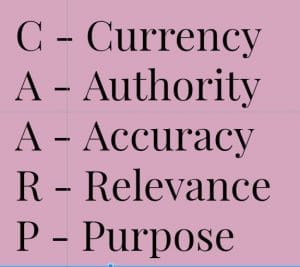 There is a plethora of information online – so how do we navigate the flood of information and recognize information that is authentic, real and something we can trust. All IB librarians are pretty familiar with the acronym – CAARP or CRAAP.
There is a plethora of information online – so how do we navigate the flood of information and recognize information that is authentic, real and something we can trust. All IB librarians are pretty familiar with the acronym – CAARP or CRAAP.
To recognize information as worthwhile and with credibility – it is important to teach our students how to question their sources. My favorite criteria is the CAARP from the California State University And, you can apply it to almost anything, a book, a website, a blog post or even a media product. To test the authenticity of the information you can also use the CARS checklist from McGraw Hill. As librarians, we must teach these to our students starting from Grade 4 all the way up to the high school students. No one is too young or too old to learn these acronyms to guide us when evaluating any source of information.
When you come across a video on Whatsapp or through social media channel, using any one of these acronyms of evaluating will help identify the authenticity and value of the information and will help you from getting carried away with fake news and other morphed videos and images. If you don’t see the creator of the video – IGNORE IT… It’s not worth passing it on.
I often tell my high school students, that if they come across some information on a website and it is only found on that particular website, and that particular information sounds unique, unbelievable or even rare, then, more often than not I would ignore it. To get an all-round perspective on a particular topic it is important that you find other credible sources that would compare, comment or even discuss it from different angles. Always when in doubt, look for other sources to compare, get perspective and viewpoints on the topic, never trust only one website, or one source for a particular topic.
Compare, contrast, think, analyze and use your own understanding to arrive at your opinion and views. This will help students and researchers to develop a grasp on a topic and get a 360 degree perspective on the topic.